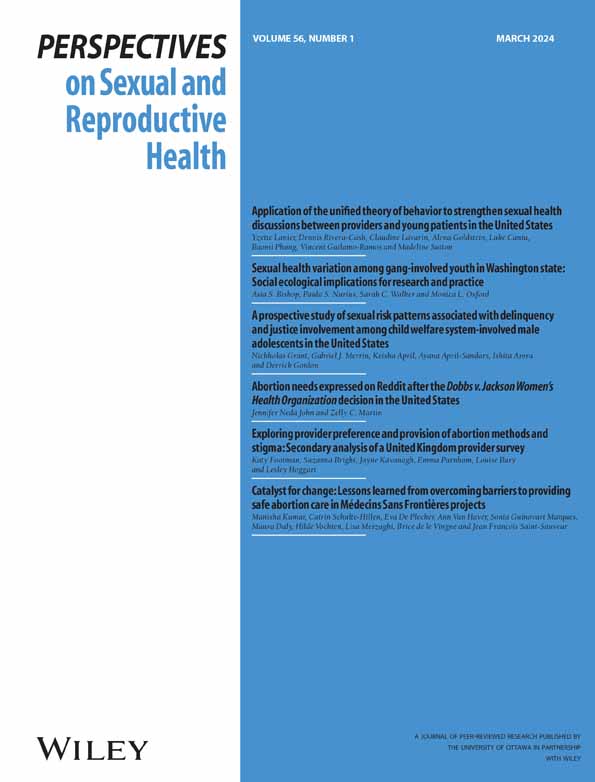Is third‐trimester abortion exceptional? Two pathways to abortion after 24 weeks of pregnancy in the United States
IF 3.4
2区 医学
Q1 DEMOGRAPHY
引用次数: 1
Abstract
Abstract Context In the United States, third‐trimester abortions are substantially more expensive, difficult to obtain, and stigmatized than first‐trimester abortions. However, the circumstances that lead to someone needing a third‐trimester abortion may have overlaps with the pathways to abortion at other gestations. Methods I interviewed 28 cisgender women who obtained an abortion after the 24th week of pregnancy using a modified timeline interview method. I coded the interviews thematically, focusing on characterizing the experience of deciding to obtain a third‐trimester abortion. Results I find two pathways to needing a third‐trimester abortion: new information, wherein the respondent learned new information about the pregnancy—such as of an observed serious fetal health issue or that she was pregnant—that made the pregnancy not (or no longer) one she wanted to continue; and barriers to abortion, wherein the respondent was in the third trimester by the time she was able to surmount the obstacles to abortion she faced, including cost, finding a provider, and stigmatization. These two pathways were not wholly distinct and sometimes overlapped. Conclusions The inherent limits of medical knowledge and the infeasibility of ensuring early pregnancy recognition in all cases illustrate the impossibility of eliminating the need for third‐trimester abortion. The similarities between respondents' experiences and that of people seeking abortion at other gestations, particularly regarding the impact of barriers to abortion, point to the value of a social conceptualization of need for abortion that eschews a trimester or gestation‐based framework and instead conceptualizes abortion as an option throughout pregnancy.妊娠晚期流产是例外吗?24岁后堕胎的两种途径 在美国怀孕周数
在美国,晚期妊娠流产比早期妊娠流产更昂贵,更难获得,并且更容易受到歧视。然而,导致需要妊娠晚期流产的情况可能与其他妊娠期流产的途径有重叠。方法采用改进时间线访谈法对28例妊娠24周后流产的顺性妇女进行访谈。我对访谈进行了主题编码,重点描述了决定进行妊娠晚期堕胎的经历。结果:我发现需要进行妊娠晚期流产的两种途径:新信息,其中被调查者了解到关于怀孕的新信息-例如观察到的严重胎儿健康问题或她怀孕了-这使得她不想(或不再)想继续怀孕;堕胎的障碍,当被调查者能够克服堕胎所面临的障碍时,她已处于妊娠晚期,包括费用、寻找提供者和污名化。这两种途径并非完全不同,有时是重叠的。结论医学知识的固有局限性和在所有病例中确保早期妊娠识别的不可行性说明消除妊娠晚期流产的必要性是不可能的。受访者的经历与在其他妊娠期寻求堕胎的人的经历之间的相似之处,特别是关于堕胎障碍的影响,指出了对堕胎需求的社会概念化的价值,这种概念化避免了孕期或基于妊娠的框架,而是将堕胎概念化为整个妊娠期的选择。
本文章由计算机程序翻译,如有差异,请以英文原文为准。
求助全文
约1分钟内获得全文
求助全文
来源期刊
CiteScore
5.10
自引率
3.40%
发文量
24
期刊介绍:
Perspectives on Sexual and Reproductive Health provides the latest peer-reviewed, policy-relevant research and analysis on sexual and reproductive health and rights in the United States and other developed countries. For more than four decades, Perspectives has offered unique insights into how reproductive health issues relate to one another; how they are affected by policies and programs; and their implications for individuals and societies. Published four times a year, Perspectives on Sexual and Reproductive Health includes original research, special reports and commentaries on the latest developments in the field of sexual and reproductive health, as well as staff-written summaries of recent findings in the field.

 求助内容:
求助内容: 应助结果提醒方式:
应助结果提醒方式:


